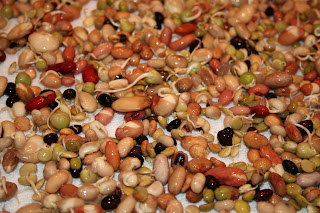Whole foods can be so easy and simple that even kids can make them! The pictures in this article are of my son making Alfredo Sauce from scratch! In every picture where you see hands, they belong to my 11 y/o son. This recipe has become his trademark. He does a fabulous job. Even he says it is so much better than the jarred sauce we used to buy - and we didn't buy the cheap stuff, either.
We have adapted this recipe from one showcased on "Down Home with the Neelys" on Food Network.
Alfredo Sauce
2 TBSP Butter (from pasture-raised cows would be best)
1 TSP Minced Garlic (I personally like a bit more)
1 TBSP All Purpose Flour (I would not use whole wheat flour here, as it has such a strong flavor on it's own, but any neutral flavored flour, as long as it is not self rising, should work here. I use Spelt.)
1 Cup Heavy Cream (we get our cream off of the real, whole, raw milk we drink)
1/4 Cup Parmesan Cheese (grated/shredded)
Salt and Pepper to taste
Mise en Place:
1. Melt Butter in a skillet.
2. Add chopped garlic.
3. Stir/sautee for a minute or so. DO NOT brown the butter or garlic. You just want to "wake up" the flavor of the garlic.
4. Add Flour.
5. Whisk in pan until smooth.
6. Add Cream.
7. Whisk until warm/hot, Not boiling.
8. Add Cheese.
9. Keep whisking until cheese has melted completely.
10. Add Salt and Pepper to taste.
(OK, time for a confession... I didn't get a picture of the final product. We gobbled it up too quickly. I'll try to remember to get one next time we make this Alfredo Sauce!)
Use anywhere you would use Alfredo Sauce. I love it over chicken or as the sauce on a "white pizza." If you like pasta, this will work with about 1/3 - 1/2 lb of Angel Hair pasta.
This post is linked up at Traditional Tuesdays and Real Food Wednesdays.
We have adapted this recipe from one showcased on "Down Home with the Neelys" on Food Network.
Alfredo Sauce
2 TBSP Butter (from pasture-raised cows would be best)
1 TSP Minced Garlic (I personally like a bit more)
1 TBSP All Purpose Flour (I would not use whole wheat flour here, as it has such a strong flavor on it's own, but any neutral flavored flour, as long as it is not self rising, should work here. I use Spelt.)
1 Cup Heavy Cream (we get our cream off of the real, whole, raw milk we drink)
1/4 Cup Parmesan Cheese (grated/shredded)
Salt and Pepper to taste
Mise en Place:
1. Melt Butter in a skillet.
2. Add chopped garlic.
3. Stir/sautee for a minute or so. DO NOT brown the butter or garlic. You just want to "wake up" the flavor of the garlic.
4. Add Flour.
5. Whisk in pan until smooth.
6. Add Cream.
7. Whisk until warm/hot, Not boiling.
8. Add Cheese.
9. Keep whisking until cheese has melted completely.
10. Add Salt and Pepper to taste.
(OK, time for a confession... I didn't get a picture of the final product. We gobbled it up too quickly. I'll try to remember to get one next time we make this Alfredo Sauce!)
Use anywhere you would use Alfredo Sauce. I love it over chicken or as the sauce on a "white pizza." If you like pasta, this will work with about 1/3 - 1/2 lb of Angel Hair pasta.
This post is linked up at Traditional Tuesdays and Real Food Wednesdays.













